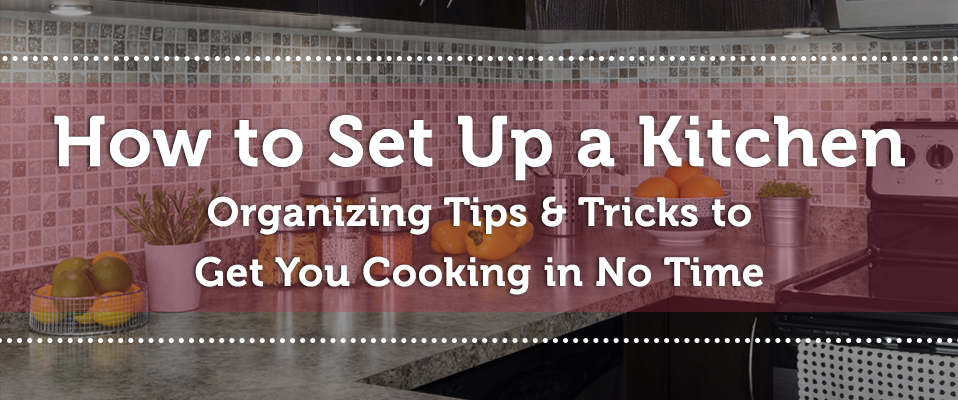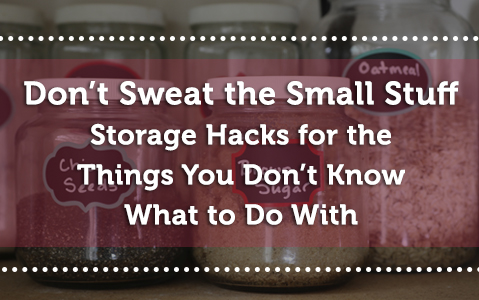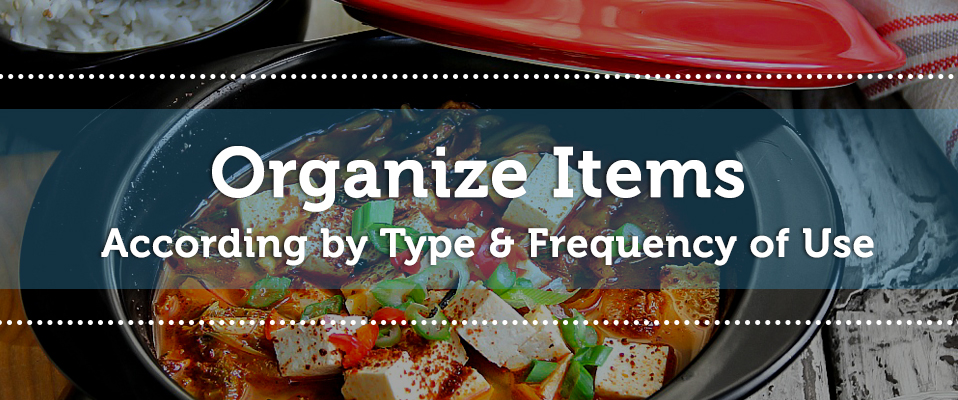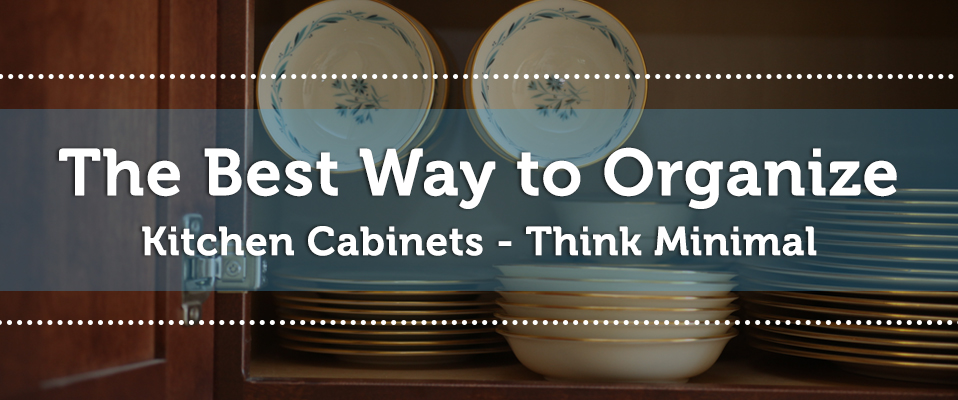
We’ve all been there, especially those of us who aren’t exactly the kind of type-A organizer pros who color-code everything from calendar entries to bathroom supplies. For most of us, the unorganized kitchen represents a looming challenge — a literal mountain of pots, pans, useless apple-corers and can openers that don’t even do their job properly. When faced with the nightmare that is the chaotic kitchen, one will frequently find themselves subject to the cycle of takeout — which while often tastier (and more convenient) than your own concoctions, is far more expensive and much less healthy than making your own meals from home.
For that reason, we’ve put together a list of steps toward a clean and organized kitchen setup you’ll actually want to use.
The Best Way to Organize Kitchen Cabinets — Think Minimal
Here’s the thing. A big part of why an unorganized kitchen is so daunting is the sheer amount of useless items that take up space, restricting access to that one pan you need to make the perfect stir-fry. Cleaning out our cabinets — and we’re talking a full-on overhaul here — is the first step into getting the kind of television-ready kitchen of your dreams.
Start by making a list of the things you’ll need for cooking, and don’t go overboard. Think pots and pans (just a few if you aren’t a professional chef), knives, dishes and the miscellaneous items you need. Are you a die-hard fan of the food processor? Can’t live without that juicer or blender? Great, those can stay. However, stay away from over-specific items like that quesadilla maker you thought would change your life, that tiny pan that only cooks eggs or that giant contraption dedicated exclusively to opening bottles of wine. We all get sucked into the kinds of as-seen-on-TV nonsense that promises to make your kitchen life easier, but in reality just takes up space. Don’t fall victim to the more is more mentality. It’s a slippery slope toward creating the kind of overwhelming clutter that may make you stop cooking altogether. If you find you have a lot of stuff you don’t need, donate it to Goodwill or a shelter that prepares food for the homeless.
Ditch any non-stick cookware that is peeling or has the coating breaking off. Aside from not looking its best, less than fresh non-stick coating can leach chemicals into your food, which sort of eliminates the point of sautéing all that kale. It’s always nice to get a fresh start. If you’re looking to replace some of that old, crusty cookware in favor of something new, check out our collection of Xtrema ceramic cookware.
Don’t Forget the Wall Space
Short on cabinet space? We’re all in the same boat here. Even the best organizers among us can run out of room to store some of the hardest working kitchen utensils. Not to worry, there’s plenty of storage space hiding right in plain sight.
Lose the knife block in favor of a magnetic knife strip, hang it above the oven for easy access. Do the same for your spatulas and larger utensils — try hanging them on wall hooks, near where you’ll actually be using them. How often have you burnt something because you’ve had to turn your attention away from sizzling eggs and bacon to search for a spatula?
As far as spices go, we can get bogged down sometimes with tons of near empty containers filling the pantry and never thrown away. A good tip for getting around this also involves magnets. You’ve probably seen this on countless Pinterest boards and home décor sites, but it’s for good reason. Get some small jars and attach them to the wall with magnets. You’ll be able to easily see how much you have in stock at any given time, and keep a wall of flavors at your fingertips.
Best of all, you’ll eliminate the problem of collecting too many containers. Fill your spices up at a grocery store that sells items in bulk, you might even save a few bucks while at the same time helping the environment.
Tackling the Fridge and Freezer
Yikes. Welcome to the next phase of the great kitchen clean out. We’re going to venture a guess and assume your fridge and freezer are loaded with items that haven’t seen the light of day in months, or possibly years. Fair enough. Many things keep for a while, and it can save you a lot of time and money to save some meals for rainy days. But, hanging on to the crusty remains of a jar of mustard isn’t exactly practical or economical. Neither is that collection of old salsas lining the very back of your refrigerator.
For the messiest among us, it can be beyond daunting to tackle that mess of old take out and leftover spaghetti noodles you probably knew you were never going to eat. In any case, it’s better to bite the bullet and do a complete overhaul of the fridge. Grab a bunch of trash bags and go to town. Check expiration dates and ditch any loose produce you don’t remember buying.
Another quick tip for keep things clean for the long haul: before you take out your normal load of kitchen trash, check the fridge to see if any leftovers have passed their prime. Throwing out old food on a weekly basis helps keep the fridge neat, organized and free from mysterious odors. Remember to wipe down any sticky surfaces, and throw in an open box of baking soda to keep things smelling fresh.
Clean Out the Pantry
Another space chock full of junk food, unidentified cans, paper plates and who knows what. The pantry is a cool kitchen feature that can quickly turn into a giant junk drawer. Not to sound like a broken record, but the same principles apply here as the fridge and the rest of the cabinets: clean it out completely, toss or donate what you don’t need and rebuild with the basics.
Don’t Sweat the Small Stuff — Storage Hacks for the Things You Don’t Know What to Do With
-
Fill the Junk Drawer with Small Bins — If you have a junk drawer (or several) brimming with all the small items you’d rather not address, stock up on small bins or jars and organize the space according to like items. It’ll be easier to find things like pens, paper clips and other small items that don’t quite fit into the kitchen utensil mold.

-
Glass Containers for Bulk Items — Keep things like oatmeal, rice and dried beans in glass containers. You’ll avoid the bulk of various cardboard boxes, as well as add a touch of style to your kitchen space. You may be able to fit them in a drawer, pantry or right on the counter if you have room.
-
Drawer Dividers — The junk drawer, or even a dedicated utensil drawer for that matter, are a unique beast to tackle. We all need a place to keep all the little odds and ends that accumulate, but they quickly can turn into a big mess. Add drawer dividers to those drawers that house many small parts. Separating your scissors from your can opener and your kitchen first aid kit will help you find what you need in no time at all.
Utilize Under the Sink Storage
Don’t waste precious counter space on soggy sponges and dish scrubbing brushes. Move them out of sight. Try hanging these dirty dish warriors on hooks attached to the cabinet door, so they can dry without adding any extra clutter. Remember to place a tray beneath anything that drips to avoid any water damage. Additionally, this area is best dedicated to your cleaners, extra sponges and the like. Don’t put food under here, as you won’t want to get it mixed up with cleaners and chemicals. Install some small racks on the back side of the door. This will make it easier to find your wipes, cleaning spray and extra detergent.
Organize Items According to Type, As Well as Frequency of Use

This one seems a little bit obvious to seasoned organizers, but poorly organized spaces lead to lack of use. We often store things where they fit if they haven’t been reorganized from the bottom up — so be sure you’ve actually cleaned out the cabinets before starting this step.
Arrange your kitchenware according to how often it gets used, putting everyday plates and mugs in a grab-and-go location, while the fine china or heirloom silver gets stowed away on a higher shelf, or perhaps even away from the precious kitchen space.
Rethink Your Drawers
Think your drawers are only good for housing silverware and hiding things you should really just throw away? Well, think again. Let your imagination run wild with all the storage possibilities at your fingertips. Yes, eating utensils are easily stored in drawers, but so are small plates, spices and dry foods. Try organizing plates and cups by adding a drawer liner and rubber stoppers as a divider. This will free up cabinet space for pots, pans or whatever else, not to mention, provide easy access for those cooks who aren’t blessed with long arms and legs.
Think Vertically
Think that you should confine glasses and utensils to doors and cabinets? Why be like everyone else facing the same struggles with kitchen space. The best way to organize a kitchen is to think outside the cabinets and look to the walls for inspiration. Place hooks beneath cabinets or against the wall, which will free up that valuable cabinet space. There are racks specifically made for storing plates, mugs or even wine glasses up against the wall.
Embrace the Rack and File
Think filing is just for the office? Wrong — it can take your kitchen from chaos to order with minimal effort. Here are a few ideas:
Pots and Pan Rack — Look, you might think that gorgeous hanging sets of pots and pans only belong in fancy restaurants or television cooking shows. But, the reason they’ve achieved ubiquity in settings synonymous with high class dining is because it’s an ingenious way to organize some of the hardest workers in the whole kitchen. If you’re short on space, try hanging them above the oven range, they’ll be easily accessible right where you need them to be, which sure beats combating a tumbling avalanche of cookware each time you want to boil some noodles. If you go this route, be sure to make sure the rack can support the weight of all that hefty metal.
Rethink the Plate Cabinet — Skip the usual stacks of plates in the cabinet. Get an upright rack, similar to what you’d see organizing files in an office and stick your plates in there. Not only is it a more unique approach to dish storage, you’ll be able to easily grab a plate, without rifling through them all with your hands above your head trying in an attempt to find the right one.
Baking Sheets — Like the plate filing method, file baking sheets using a dividing rack and just line ‘em up. Baking sheets, while not exactly bulky, often contribute to the annoying mountain of the pots and pans cabinet, making an awkward pile of hard to find supplies, always ready to topple.
Lids, Lids, Lids — Look, it does feel a bit wasteful, but a Tupperware container without a lid is almost useless. Toss it. Get rid of all containers that don’t have lids (that are supposed to), and go through your collection pairing lid with container as you go along. Alternatively, you can store the lids in their own container, or file them with a divider. The downside to this method is, the lids are separated from their corresponding container, eventually you may find some are missing if you’re not careful. Another option (and this works for pot and pan lids too) is to store them on their sides in the cabinet on a wire rack.
Use Lazy Susans
Don’t underestimate the power of the lazy Susan. These restaurant staples are incredibly versatile in the home kitchen, and can easily store all kinds of stuff that’s great to have on hand, while making use of a tight space. Throw your favorite spices in the mix, oils and vinegars or even vitamins and medications that sometimes take up too much cabinet space. The reason this not-so-lazy tray works so well is it eliminates the need to go digging around for one item buried behind many other things. No one wants to dig out a whole shelf’s worth of spices just to find the hot pepper flakes. It’s truly the little things that add up to make a kitchen run smoothly. Another way to use the lazy Susan is to stick one or two in the fridge, they’re perfect for drinks, condiments or small containers of leftovers.

Ditch the Cookbooks
We’re living in the digital age! If you’re short on space, lose the hefty cookbooks and invest in a slick-looking stand for your iPad or tablet, so you can use it to view recipes. We realize this might be controversial for some readers, as our favorite cookbooks are often items that have been well loved and well worn, with the grease stains and globs of flour to prove it. We’re not saying throw away grandma’s recipe cards or anything else that offers sentimental value, but take inventory, and donate the ones that aren’t in the heirloom category. Let’s be honest here, you definitely don’t need 20 cookbooks devoted to the art of crafting the perfect green smoothie. Keep a few on a bookshelf and free up some precious real estate.
Hungry for More Kitchen Ideas? Check Out Our Blog
Now that you’ve got organization covered, let’s move on to the tastier stuff. We’ve got an arsenal of tips and tricks to get you up to speed in the kitchen — from summer salad recipes to how to properly cook a steak and much more. At Ceramcor, we not only sell cookware, bakeware and dinnerware, we also like to provide you with the best ways to use them and keep them in tip top shape for the long haul.
